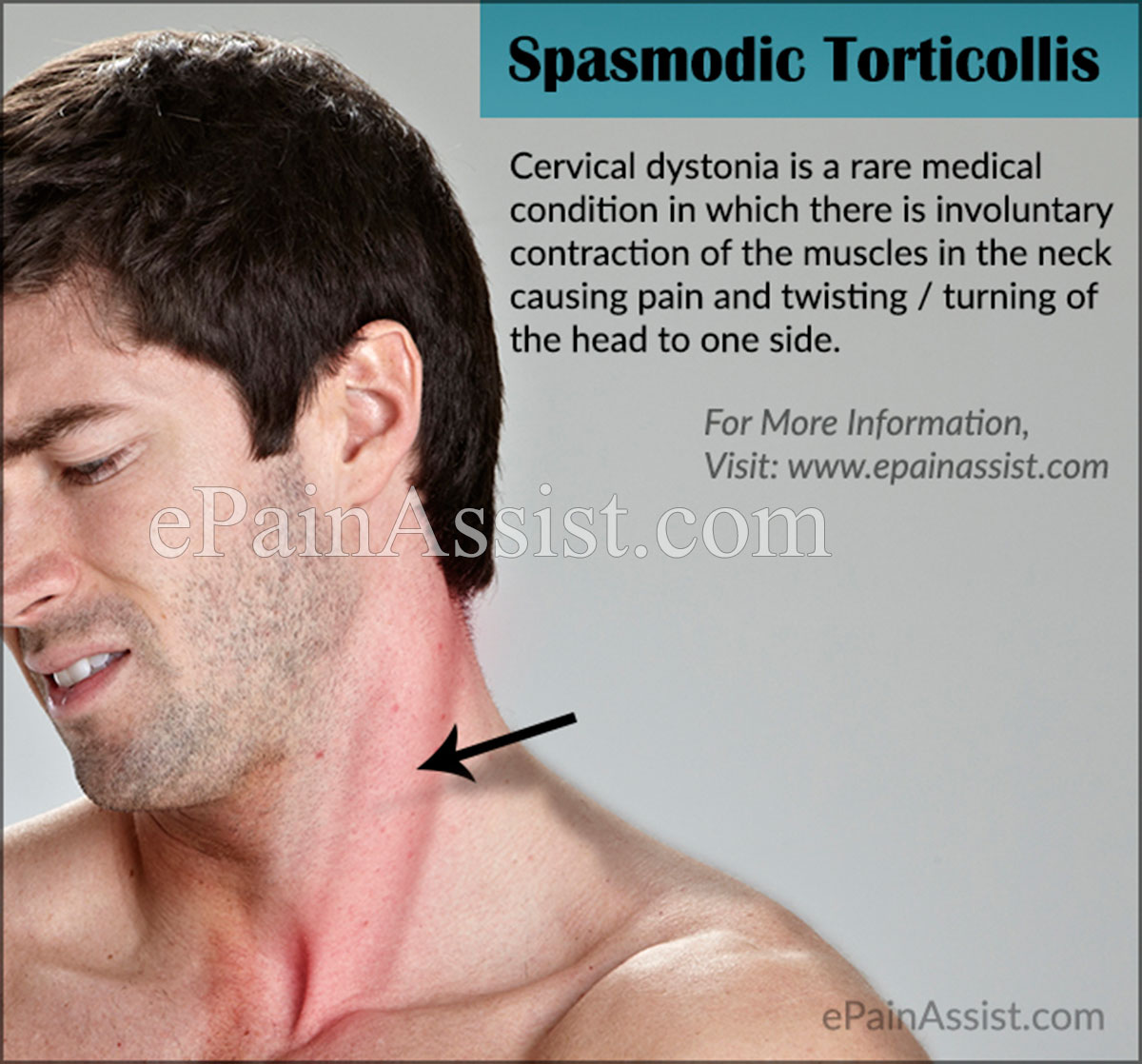Spasmodic torticollis, also known as cervical dystonia, is a rare medical condition in which there is involuntary contraction of the muscles in the neck causing pain and twisting/turning of the head to one side.1 Spasmodic torticollis can also cause uncontrollable forward or backward tilting of the head. This disorder can occur at any age and even in infancy; however, most commonly tends to affect middle-aged individuals and women more than men. Symptoms begin gradually and then escalate, and finally plateau where they do not get significantly worse.

Spasmodic torticollis has no cure. This disorder can sometimes resolve without any treatment, and sustained remissions are rare. Botulinum toxin injection into the affected muscles helps in alleviating the signs and symptoms. Surgery can be done in few cases.
Causes & Risk Factors of Spasmodic Torticollis
In many of the cases the cause is not known. Doctors are still not able to understand why some people develop this disorder and some don’t. There are some cases though, which seem to be associated with neck, head or shoulder injuries. Other than this, there are certain medicines, such as antipsychotics or anti-nausea drugs, which can trigger spasmodic torticollis in some patients. Risk factors comprise of age, where this disorder can affect anyone; but middle aged people are more prone to it. Women are at an increased risk to develop spasmodic torticollis than men. There is also an increased risk for developing this condition if someone has a family history of spasmodic torticollis.
Signs & Symptoms of Spasmodic Torticollis
The contractions of the neck muscles cause the head to turn or twist in different directions, such as:
- The chin can get pulled towards the shoulder. This is the most common symptom.
- The ear can turn towards the shoulder.
- The chin can turn straight up or straight down.
- Some patients have a combination of abnormal head postures.
- Patient can also experience neck pain which can radiate towards the shoulders.
- Patient may also experience a jerking motion of the head.
- Patient may also have headaches.2
- Sometimes the pain can be quite exhausting and debilitating.
Investigations for Spasmodic Torticollis
Physical examination is sufficient to confirm the diagnosis of Spasmodic Torticollis. However, it is important to find out if there are any underlying medical conditions, which are producing the signs and symptoms. For this, tests which need to be done include:
- Blood and urine tests help in revealing the presence of toxins.
- MRI or Magnetic Resonance Imaging is an imaging test, which helps in identifying tumors or any evidence of stroke.
- EMG or Electromyography is a test which measures the electrical activity in the muscles.3 This helps in diagnosing disorders of the nerves and muscles, confirms the diagnosis of spasmodic torticollis or some other condition if any.
Treatment for Spasmodic Torticollis
Spasmodic Torticollis has no cure. In some patients, symptoms can resolve without any treatment, however, recurrence is common. The aim of treatment is alleviating the signs and symptoms of this condition.
Medications
A different combination of medications is used to reduce the signs and symptoms, such as:
Botulinum toxin, commonly known as Botox, is a paralyzing agent, often used for smoothing facial wrinkles. This can be directly injected into the neck muscles which are affected by spasmodic torticollis. Some of the botulinum toxin drugs are Botox, Xeomin, Dysport and Myobloc. Many patients improve with this treatment, but injections need to be repeated every three to four months.
Muscle relaxants also help in reducing the symptoms; however, there are side effects, such as sedation, mild cognitive impairment and balance problems.
Parkinson’s drugs are given to alleviate tremors, which are seen with Parkinson’s disease. These medicines can be used in conjunction with botulinum toxin injections.
Some of the common side effects include constipation, dry mouth, memory problems, blurry vision and reduced urinary stream.
Pain medications help with the pain experienced in spasmodic torticollis. These can be over-the-counter pain relievers, such as paracetamol, to prescription pain medications.
Therapy such as physical therapy can be done to reduce the signs and symptoms of spasmodic torticollis and it comprises of:
- Exercises which help in improving the strength and flexibility of the neck.
- Neck brace can be used.
- Patient can be trained in stress management techniques.
Surgical Procedures
If the above mentioned, less invasive treatments do not help, then surgery can be done which includes:
- Selective denervation surgery is the cutting of the muscles or nerves, which are responsible for the contorted neck posture and can be done for those patients who do not benefit from medications or botulinum toxin injections. This surgery is not widely available.
- Deep brain stimulation or DBS is a surgical procedure where a small hole is made in the skull and a thin wire is guided into the brain and the tip of the wire is placed in that region of the brain which controls movement. Electrical pulses are then passed through the wire to interrupt the nerve signals which are causing the twisting of the head. This procedure is only done in difficult cases of spasmodic torticollis.
Lifestyle & Home Remedies for Spasmodic Torticollis
- Getting proper rest and sleep is important as symptoms are often reduced during sleep. It is important to take short breaks or naps during the day to relax the muscles.
- Reducing stress by avoiding situations, which cause it helps in alleviating the symptoms as anxiety and stress worsen the symptoms.
- Sensory tricks can be done, such as touching the opposite side of the affected part on the face or the back of the head. This can help in stopping the spasms temporarily. Different people benefit from different sensory tricks. Patient should find out what works for him/her and continue to use that trick.
- Heat application by using heat packs helps in relaxing or loosening the taut/stiff muscles in the neck and also helps with pain relief.
Also Read:
